Management Accounting Homework Solution: Costing and Statements
VerifiedAdded on 2023/04/06
|14
|1048
|317
Homework Assignment
AI Summary
This management accounting assignment solution addresses key concepts including job costing, process costing (weighted average and FIFO methods), and the preparation and analysis of income statements. The assignment begins with an analysis of job costing, including calculations and explanations. It then delves into cost flows and the importance of proper cost classification in income statements for effective decision-making. The solution further explores process costing, comparing and contrasting the weighted average and FIFO methods, and provides detailed calculations and interpretations. The document also examines the impact of different costing methods on reported profits and provides recommendations based on the specific scenario. Overall, the assignment provides a comprehensive understanding of core management accounting principles and their application in various business contexts.
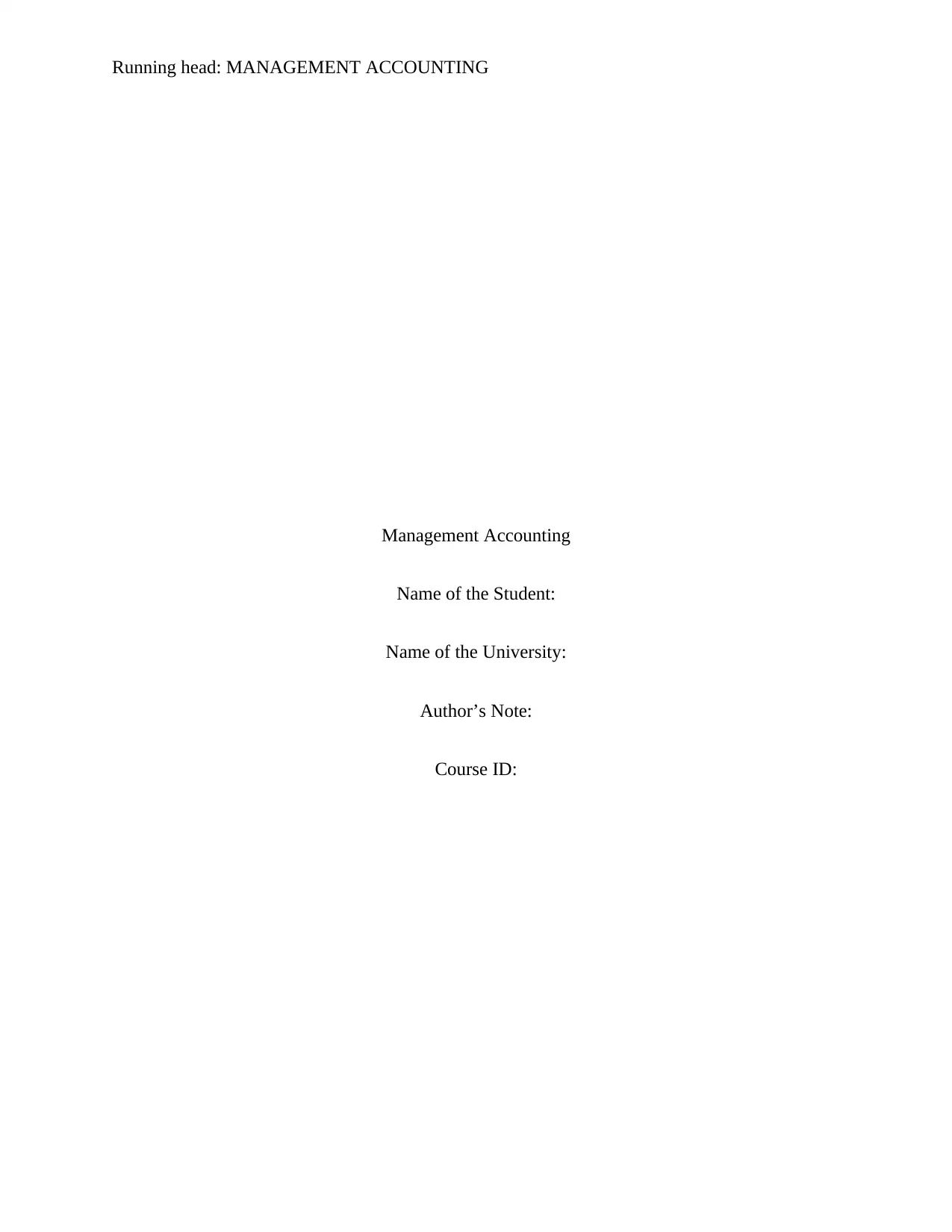
Running head: MANAGEMENT ACCOUNTING
Management Accounting
Name of the Student:
Name of the University:
Author’s Note:
Course ID:
Management Accounting
Name of the Student:
Name of the University:
Author’s Note:
Course ID:
Paraphrase This Document
Need a fresh take? Get an instant paraphrase of this document with our AI Paraphraser
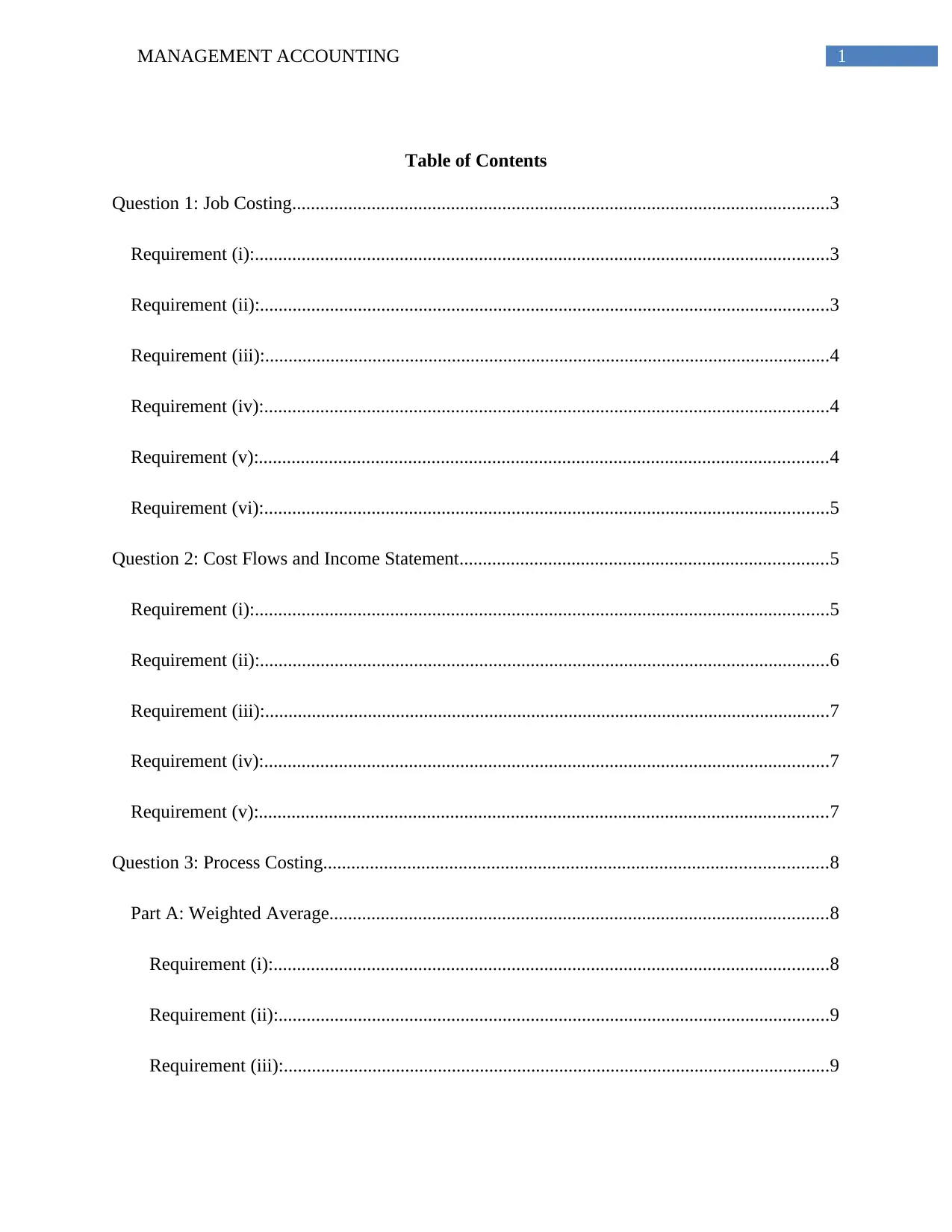
1MANAGEMENT ACCOUNTING
Table of Contents
Question 1: Job Costing...................................................................................................................3
Requirement (i):...........................................................................................................................3
Requirement (ii):..........................................................................................................................3
Requirement (iii):.........................................................................................................................4
Requirement (iv):.........................................................................................................................4
Requirement (v):..........................................................................................................................4
Requirement (vi):.........................................................................................................................5
Question 2: Cost Flows and Income Statement...............................................................................5
Requirement (i):...........................................................................................................................5
Requirement (ii):..........................................................................................................................6
Requirement (iii):.........................................................................................................................7
Requirement (iv):.........................................................................................................................7
Requirement (v):..........................................................................................................................7
Question 3: Process Costing............................................................................................................8
Part A: Weighted Average...........................................................................................................8
Requirement (i):.......................................................................................................................8
Requirement (ii):......................................................................................................................9
Requirement (iii):.....................................................................................................................9
Table of Contents
Question 1: Job Costing...................................................................................................................3
Requirement (i):...........................................................................................................................3
Requirement (ii):..........................................................................................................................3
Requirement (iii):.........................................................................................................................4
Requirement (iv):.........................................................................................................................4
Requirement (v):..........................................................................................................................4
Requirement (vi):.........................................................................................................................5
Question 2: Cost Flows and Income Statement...............................................................................5
Requirement (i):...........................................................................................................................5
Requirement (ii):..........................................................................................................................6
Requirement (iii):.........................................................................................................................7
Requirement (iv):.........................................................................................................................7
Requirement (v):..........................................................................................................................7
Question 3: Process Costing............................................................................................................8
Part A: Weighted Average...........................................................................................................8
Requirement (i):.......................................................................................................................8
Requirement (ii):......................................................................................................................9
Requirement (iii):.....................................................................................................................9
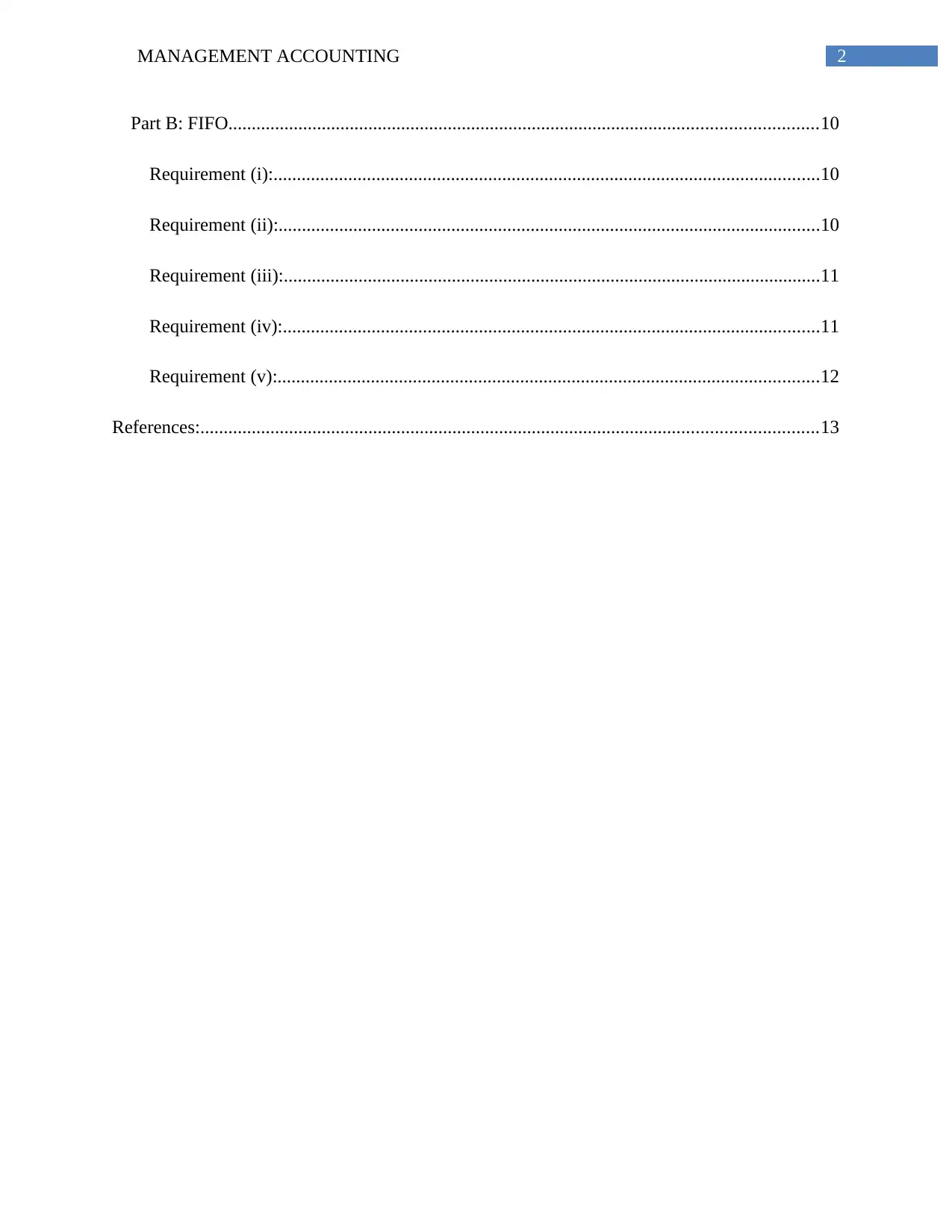
2MANAGEMENT ACCOUNTING
Part B: FIFO..............................................................................................................................10
Requirement (i):.....................................................................................................................10
Requirement (ii):....................................................................................................................10
Requirement (iii):...................................................................................................................11
Requirement (iv):...................................................................................................................11
Requirement (v):....................................................................................................................12
References:....................................................................................................................................13
Part B: FIFO..............................................................................................................................10
Requirement (i):.....................................................................................................................10
Requirement (ii):....................................................................................................................10
Requirement (iii):...................................................................................................................11
Requirement (iv):...................................................................................................................11
Requirement (v):....................................................................................................................12
References:....................................................................................................................................13
⊘ This is a preview!⊘
Do you want full access?
Subscribe today to unlock all pages.

Trusted by 1+ million students worldwide
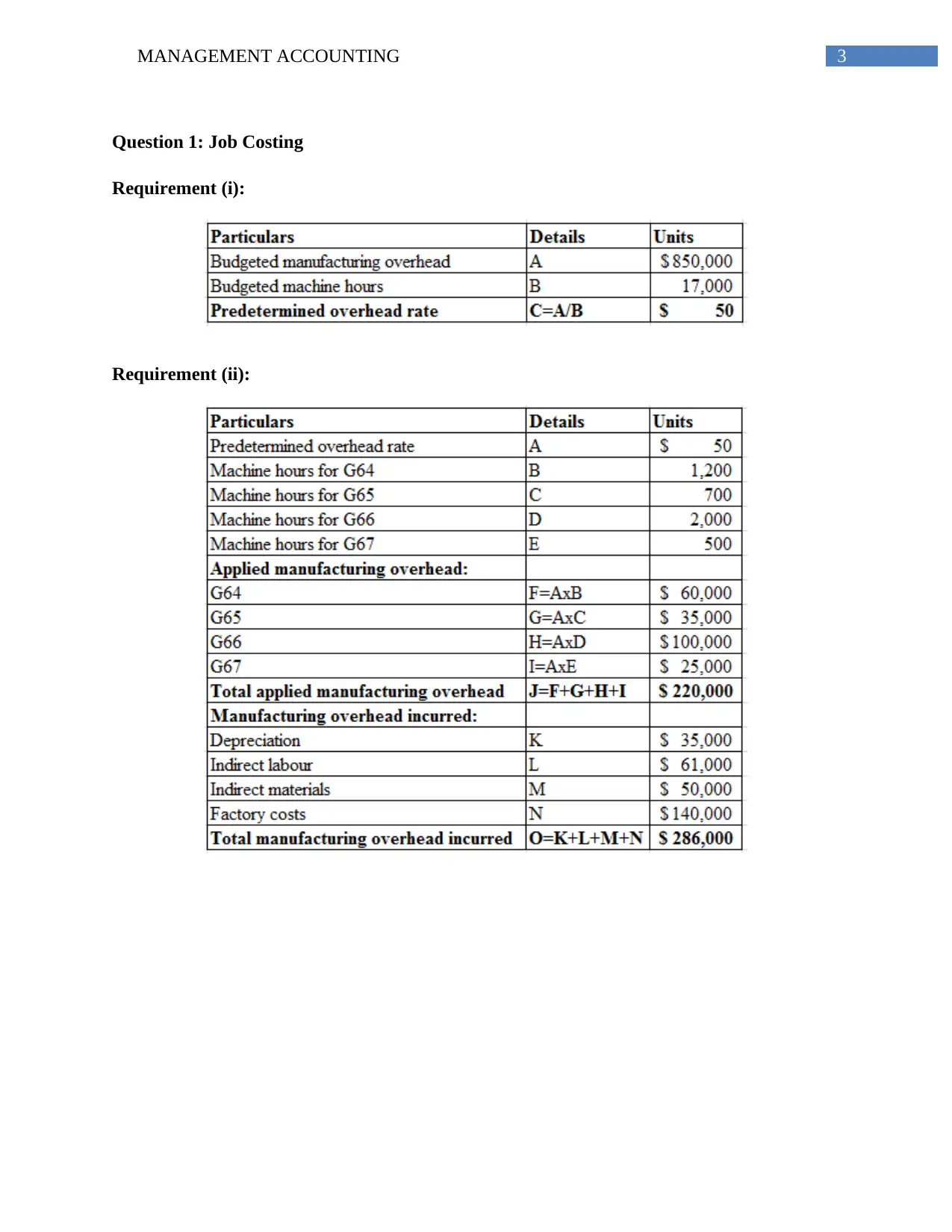
3MANAGEMENT ACCOUNTING
Question 1: Job Costing
Requirement (i):
Requirement (ii):
Question 1: Job Costing
Requirement (i):
Requirement (ii):
Paraphrase This Document
Need a fresh take? Get an instant paraphrase of this document with our AI Paraphraser
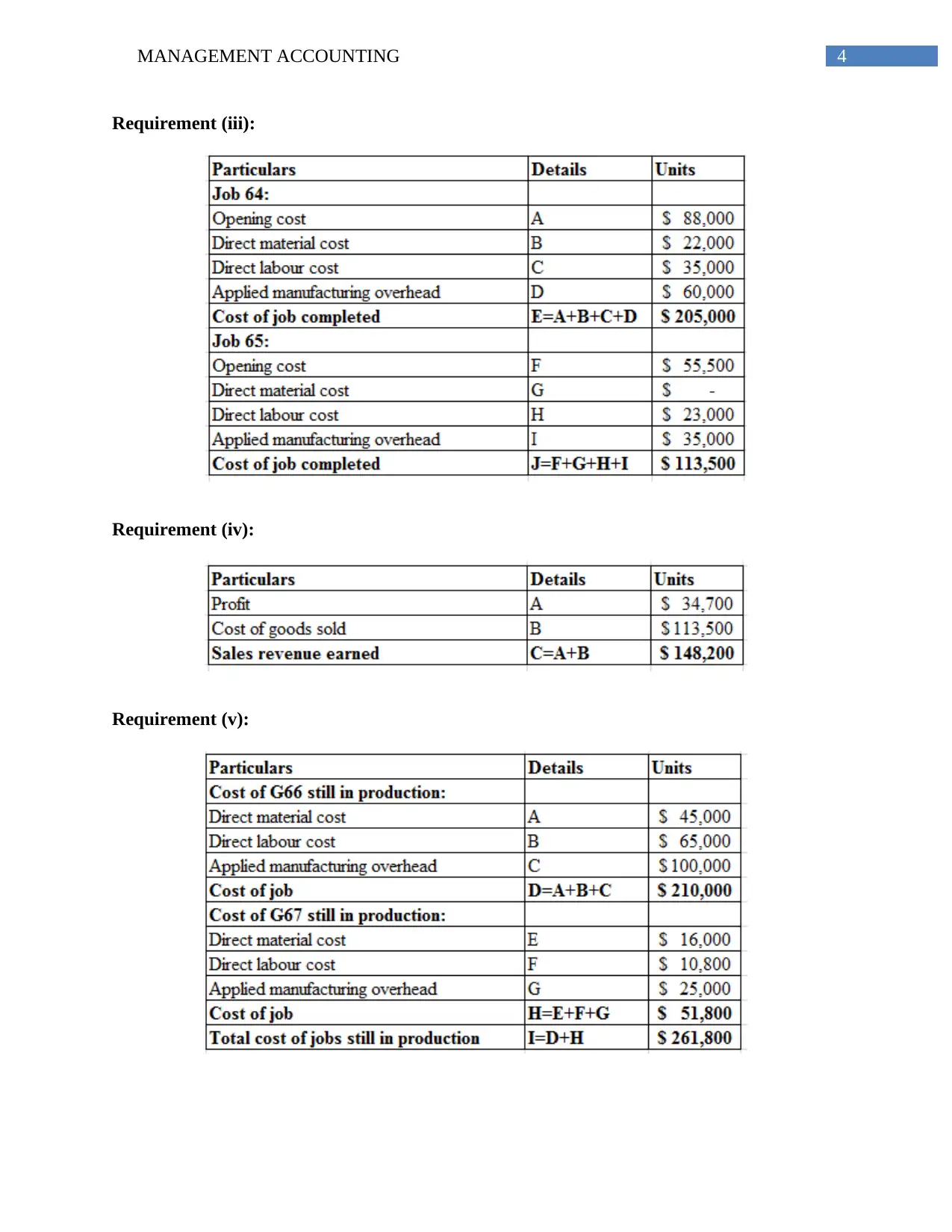
4MANAGEMENT ACCOUNTING
Requirement (iii):
Requirement (iv):
Requirement (v):
Requirement (iii):
Requirement (iv):
Requirement (v):
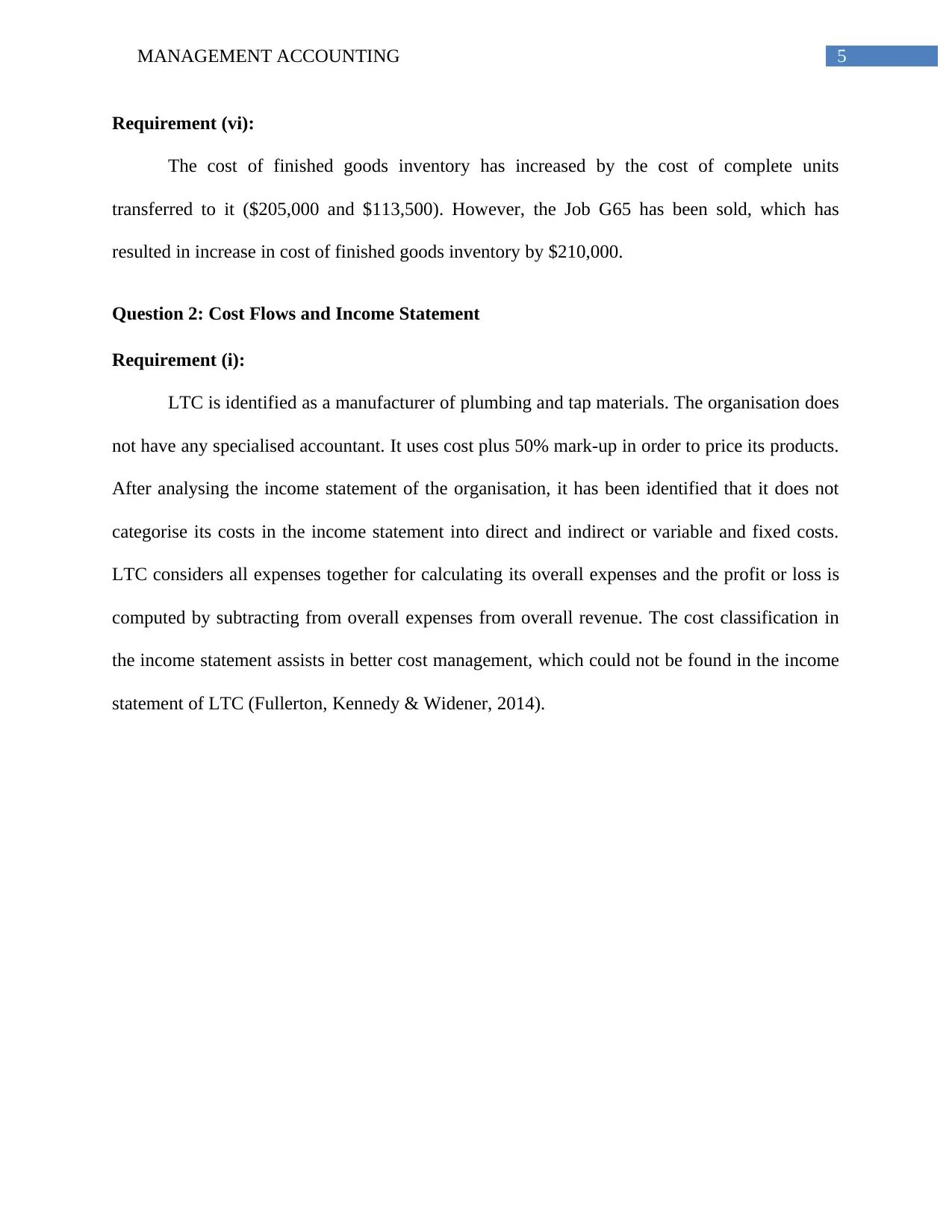
5MANAGEMENT ACCOUNTING
Requirement (vi):
The cost of finished goods inventory has increased by the cost of complete units
transferred to it ($205,000 and $113,500). However, the Job G65 has been sold, which has
resulted in increase in cost of finished goods inventory by $210,000.
Question 2: Cost Flows and Income Statement
Requirement (i):
LTC is identified as a manufacturer of plumbing and tap materials. The organisation does
not have any specialised accountant. It uses cost plus 50% mark-up in order to price its products.
After analysing the income statement of the organisation, it has been identified that it does not
categorise its costs in the income statement into direct and indirect or variable and fixed costs.
LTC considers all expenses together for calculating its overall expenses and the profit or loss is
computed by subtracting from overall expenses from overall revenue. The cost classification in
the income statement assists in better cost management, which could not be found in the income
statement of LTC (Fullerton, Kennedy & Widener, 2014).
Requirement (vi):
The cost of finished goods inventory has increased by the cost of complete units
transferred to it ($205,000 and $113,500). However, the Job G65 has been sold, which has
resulted in increase in cost of finished goods inventory by $210,000.
Question 2: Cost Flows and Income Statement
Requirement (i):
LTC is identified as a manufacturer of plumbing and tap materials. The organisation does
not have any specialised accountant. It uses cost plus 50% mark-up in order to price its products.
After analysing the income statement of the organisation, it has been identified that it does not
categorise its costs in the income statement into direct and indirect or variable and fixed costs.
LTC considers all expenses together for calculating its overall expenses and the profit or loss is
computed by subtracting from overall expenses from overall revenue. The cost classification in
the income statement assists in better cost management, which could not be found in the income
statement of LTC (Fullerton, Kennedy & Widener, 2014).
⊘ This is a preview!⊘
Do you want full access?
Subscribe today to unlock all pages.

Trusted by 1+ million students worldwide
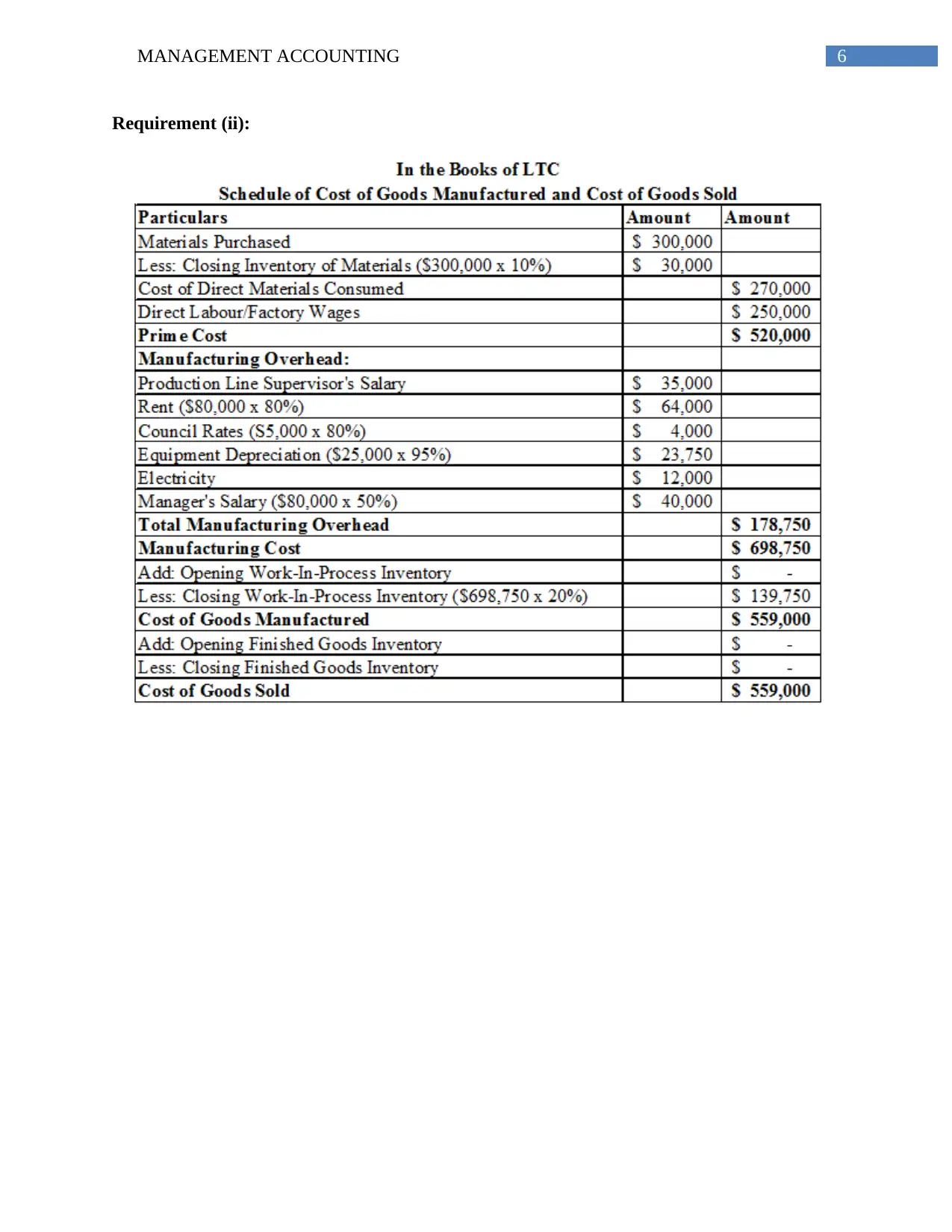
6MANAGEMENT ACCOUNTING
Requirement (ii):
Requirement (ii):
Paraphrase This Document
Need a fresh take? Get an instant paraphrase of this document with our AI Paraphraser
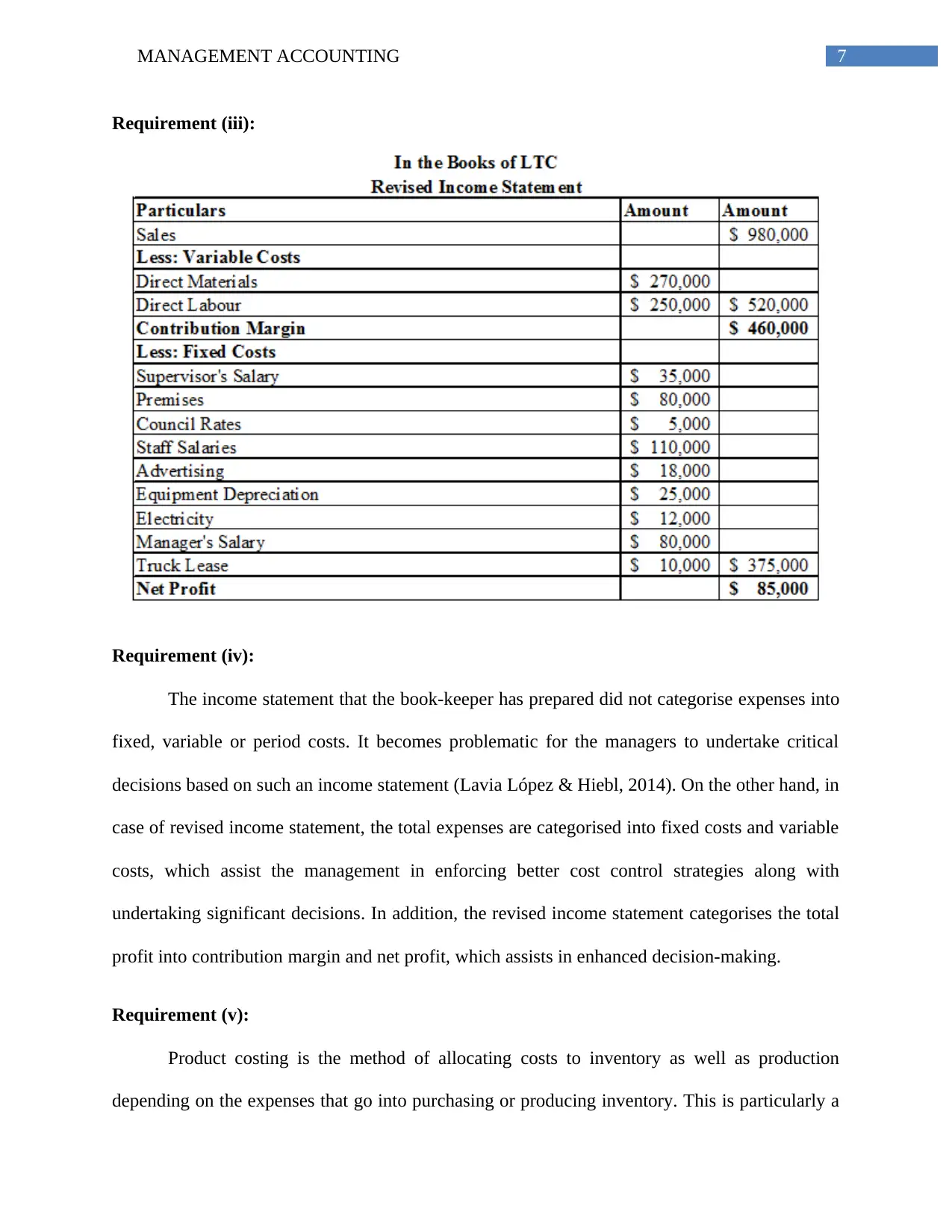
7MANAGEMENT ACCOUNTING
Requirement (iii):
Requirement (iv):
The income statement that the book-keeper has prepared did not categorise expenses into
fixed, variable or period costs. It becomes problematic for the managers to undertake critical
decisions based on such an income statement (Lavia López & Hiebl, 2014). On the other hand, in
case of revised income statement, the total expenses are categorised into fixed costs and variable
costs, which assist the management in enforcing better cost control strategies along with
undertaking significant decisions. In addition, the revised income statement categorises the total
profit into contribution margin and net profit, which assists in enhanced decision-making.
Requirement (v):
Product costing is the method of allocating costs to inventory as well as production
depending on the expenses that go into purchasing or producing inventory. This is particularly a
Requirement (iii):
Requirement (iv):
The income statement that the book-keeper has prepared did not categorise expenses into
fixed, variable or period costs. It becomes problematic for the managers to undertake critical
decisions based on such an income statement (Lavia López & Hiebl, 2014). On the other hand, in
case of revised income statement, the total expenses are categorised into fixed costs and variable
costs, which assist the management in enforcing better cost control strategies along with
undertaking significant decisions. In addition, the revised income statement categorises the total
profit into contribution margin and net profit, which assists in enhanced decision-making.
Requirement (v):
Product costing is the method of allocating costs to inventory as well as production
depending on the expenses that go into purchasing or producing inventory. This is particularly a
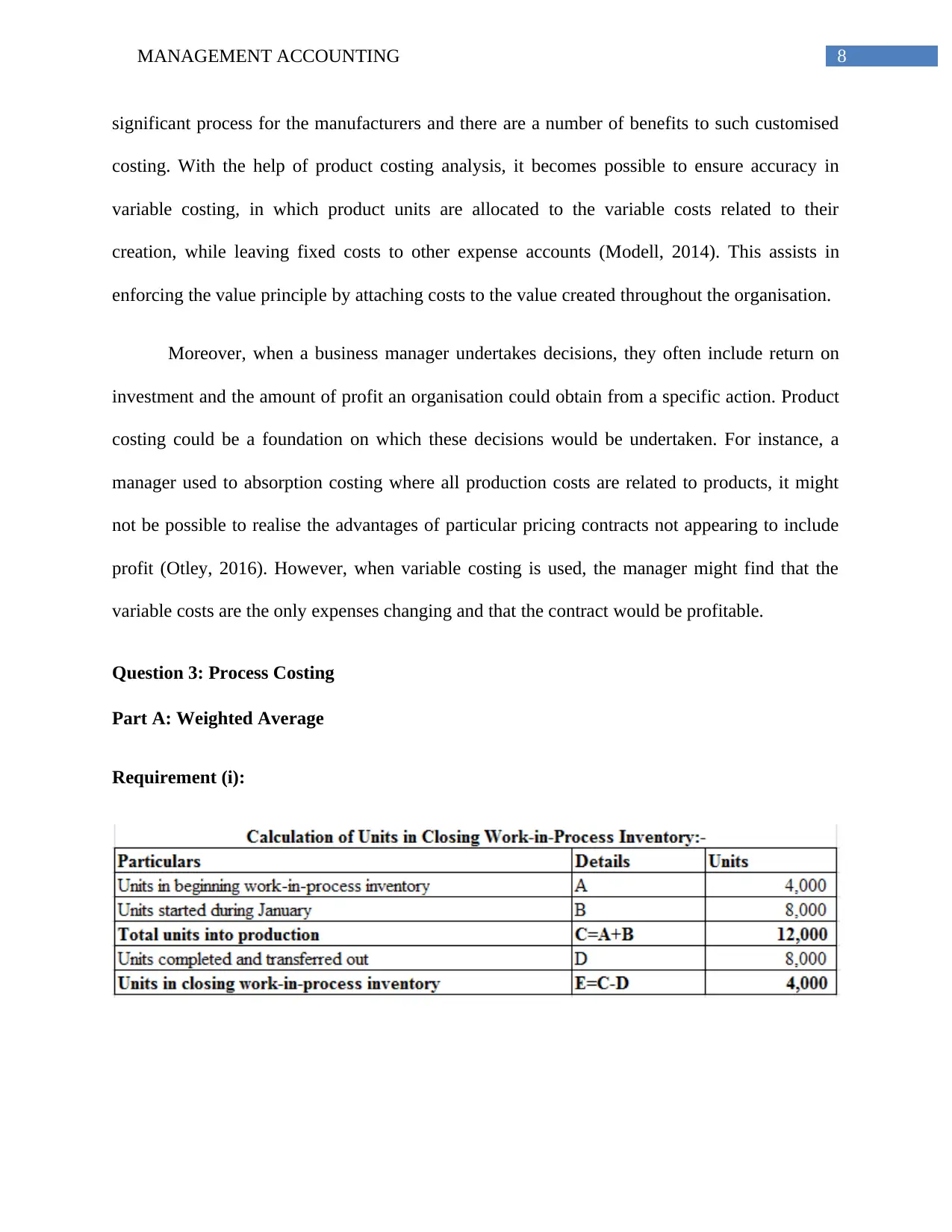
8MANAGEMENT ACCOUNTING
significant process for the manufacturers and there are a number of benefits to such customised
costing. With the help of product costing analysis, it becomes possible to ensure accuracy in
variable costing, in which product units are allocated to the variable costs related to their
creation, while leaving fixed costs to other expense accounts (Modell, 2014). This assists in
enforcing the value principle by attaching costs to the value created throughout the organisation.
Moreover, when a business manager undertakes decisions, they often include return on
investment and the amount of profit an organisation could obtain from a specific action. Product
costing could be a foundation on which these decisions would be undertaken. For instance, a
manager used to absorption costing where all production costs are related to products, it might
not be possible to realise the advantages of particular pricing contracts not appearing to include
profit (Otley, 2016). However, when variable costing is used, the manager might find that the
variable costs are the only expenses changing and that the contract would be profitable.
Question 3: Process Costing
Part A: Weighted Average
Requirement (i):
significant process for the manufacturers and there are a number of benefits to such customised
costing. With the help of product costing analysis, it becomes possible to ensure accuracy in
variable costing, in which product units are allocated to the variable costs related to their
creation, while leaving fixed costs to other expense accounts (Modell, 2014). This assists in
enforcing the value principle by attaching costs to the value created throughout the organisation.
Moreover, when a business manager undertakes decisions, they often include return on
investment and the amount of profit an organisation could obtain from a specific action. Product
costing could be a foundation on which these decisions would be undertaken. For instance, a
manager used to absorption costing where all production costs are related to products, it might
not be possible to realise the advantages of particular pricing contracts not appearing to include
profit (Otley, 2016). However, when variable costing is used, the manager might find that the
variable costs are the only expenses changing and that the contract would be profitable.
Question 3: Process Costing
Part A: Weighted Average
Requirement (i):
⊘ This is a preview!⊘
Do you want full access?
Subscribe today to unlock all pages.

Trusted by 1+ million students worldwide
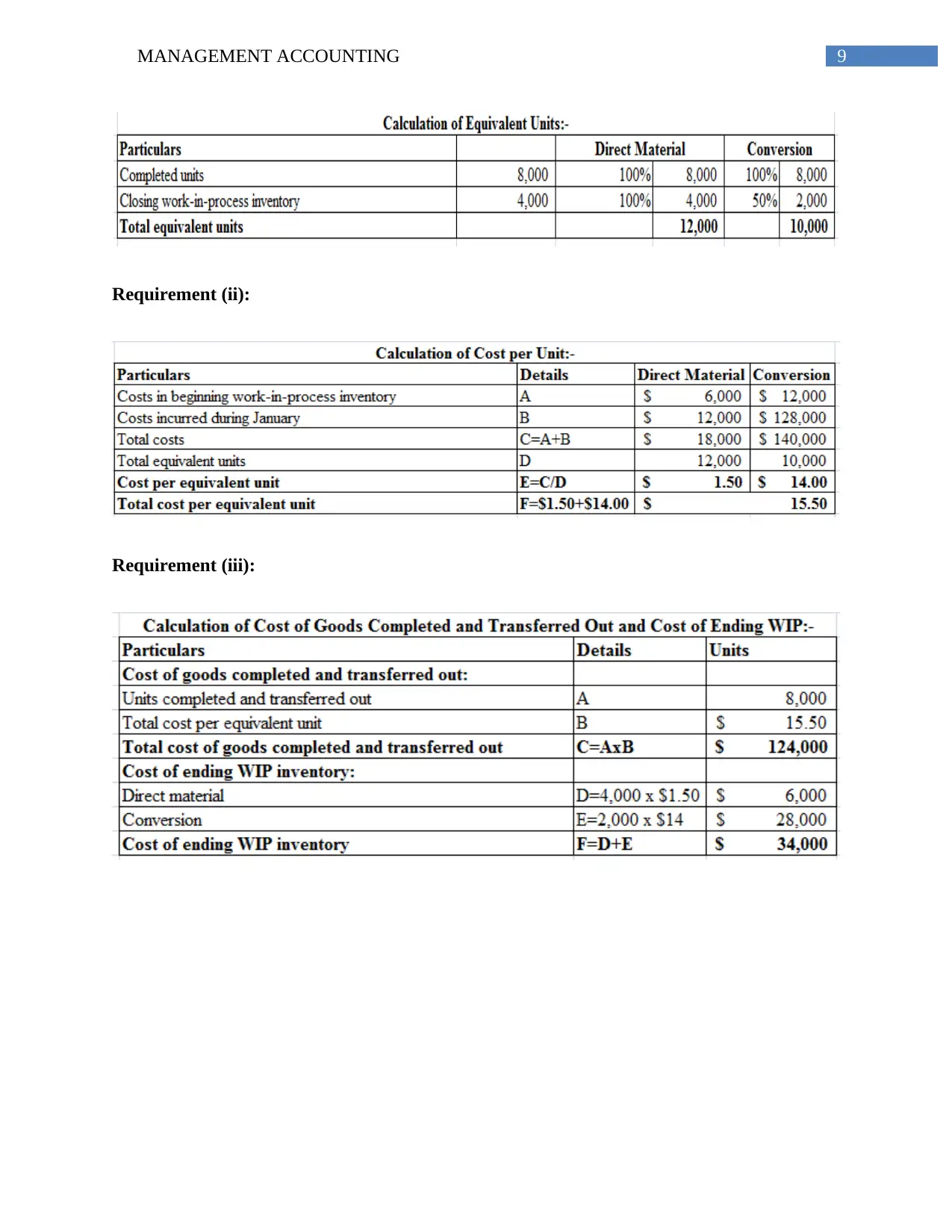
9MANAGEMENT ACCOUNTING
Requirement (ii):
Requirement (iii):
Requirement (ii):
Requirement (iii):
Paraphrase This Document
Need a fresh take? Get an instant paraphrase of this document with our AI Paraphraser
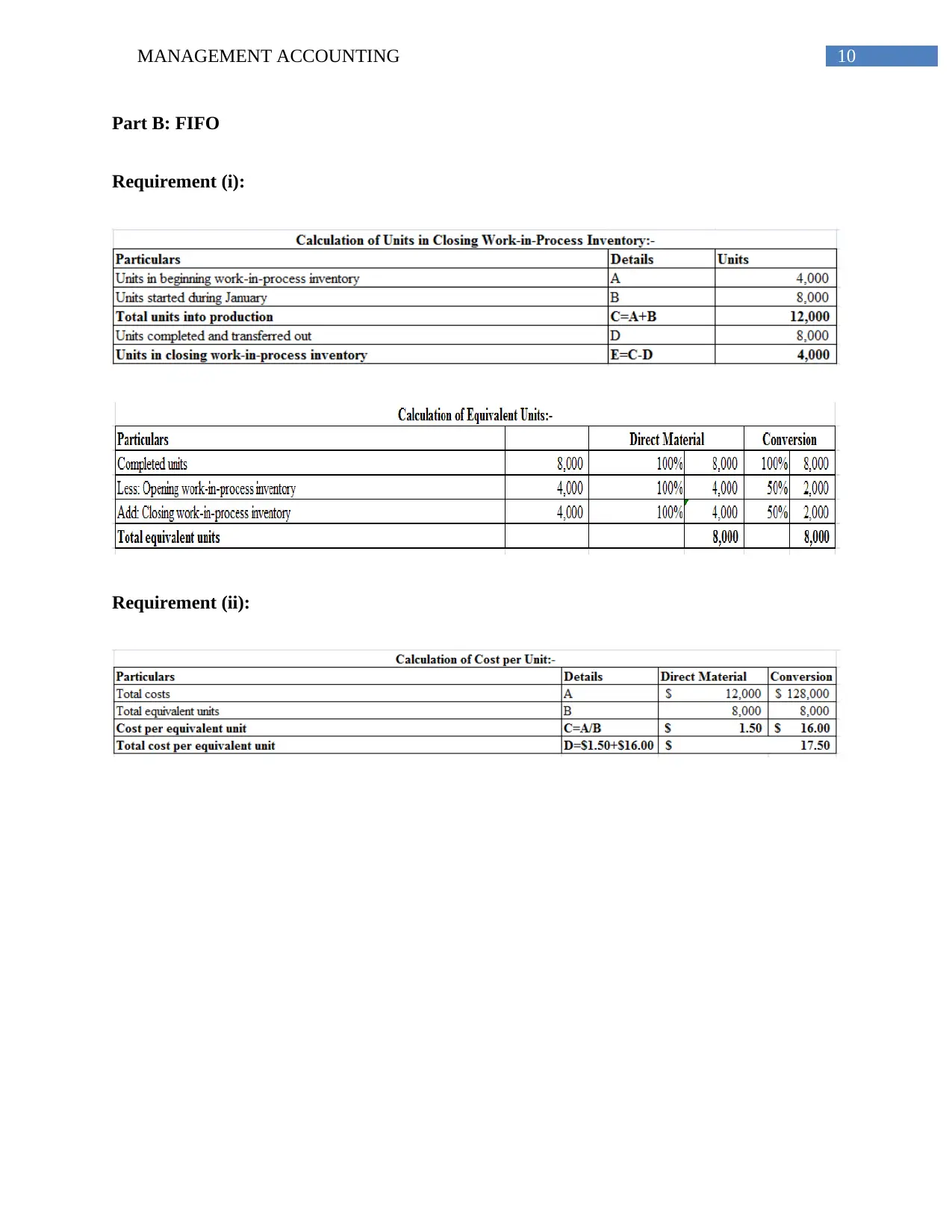
10MANAGEMENT ACCOUNTING
Part B: FIFO
Requirement (i):
Requirement (ii):
Part B: FIFO
Requirement (i):
Requirement (ii):
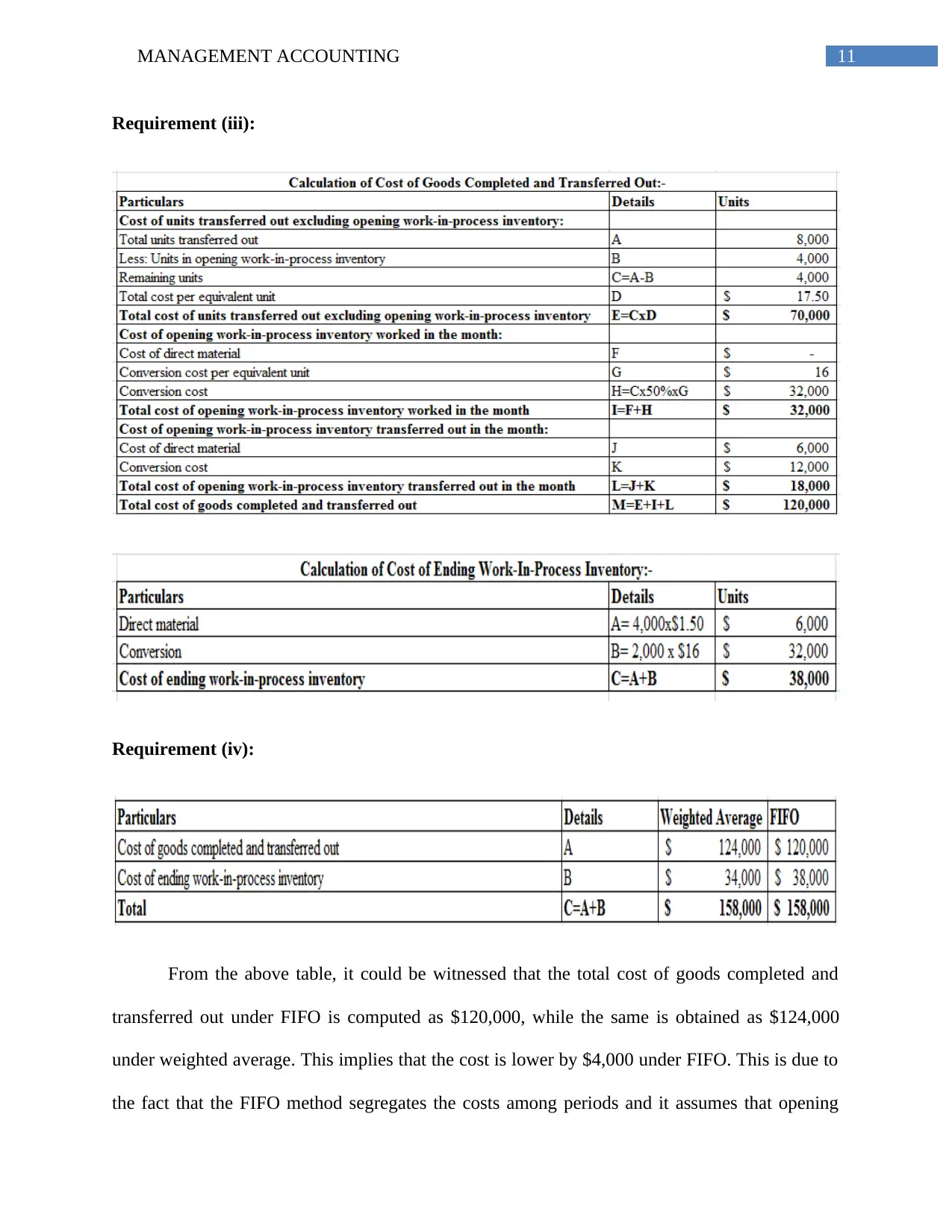
11MANAGEMENT ACCOUNTING
Requirement (iii):
Requirement (iv):
From the above table, it could be witnessed that the total cost of goods completed and
transferred out under FIFO is computed as $120,000, while the same is obtained as $124,000
under weighted average. This implies that the cost is lower by $4,000 under FIFO. This is due to
the fact that the FIFO method segregates the costs among periods and it assumes that opening
Requirement (iii):
Requirement (iv):
From the above table, it could be witnessed that the total cost of goods completed and
transferred out under FIFO is computed as $120,000, while the same is obtained as $124,000
under weighted average. This implies that the cost is lower by $4,000 under FIFO. This is due to
the fact that the FIFO method segregates the costs among periods and it assumes that opening
⊘ This is a preview!⊘
Do you want full access?
Subscribe today to unlock all pages.

Trusted by 1+ million students worldwide
1 out of 14
Related Documents
Your All-in-One AI-Powered Toolkit for Academic Success.
+13062052269
info@desklib.com
Available 24*7 on WhatsApp / Email
![[object Object]](/_next/static/media/star-bottom.7253800d.svg)
Unlock your academic potential
Copyright © 2020–2025 A2Z Services. All Rights Reserved. Developed and managed by ZUCOL.




